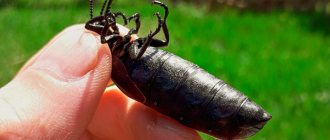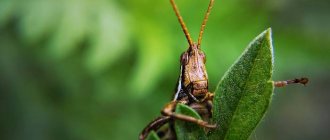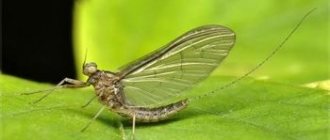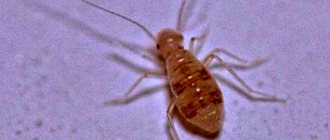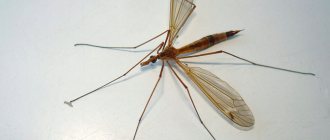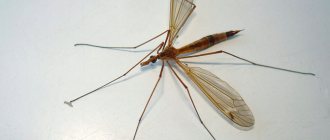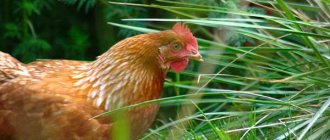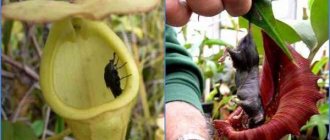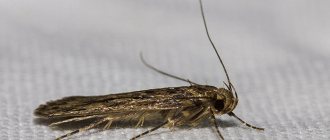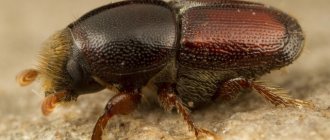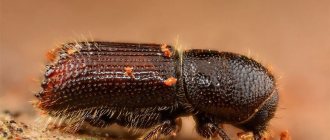Good day to all!
This article is not about a piece of clothing or even a plastic bag (although this is exactly the conclusion one could draw from reading the title), but about a beetle that I encountered in a village fifty kilometers away from the nearest regional center. Zhuque, whose full name sounds like an ordinary T-shirt (black) . This chance meeting slightly enriched my understanding of the world around me, which I would like to share with you.
Actually, voluntary self-isolation during the May holidays from civilization and its benefits (especially television and the Internet), allowed us not only to unload from the constant information stress that the media tries to crush us with every day, but also to spend time with the child in nature. And nature in the village is very close, just go out the gate and climb the nearest hill. On the hills, my daughter and I, as usual, caught green lizards and examined various beetles. Until we came across a very strange beetle, never seen before. So, welcome to one of the weekdays of an amateur entomologist)
What kind of insect is this?
This is a beetle that cannot fly. The insect lacks wings. The elytra are shortened, located close to the base, and slightly splayed to the sides at the back. The common beetle is a black or bluish-dark beetle; there are also almost azure-colored specimens. Regardless of color, the body of the beetle has a pronounced metallic tint. When you look at them, you get the impression that their body is made of metal and painted with enamel.
According to the entomological classification, they belong to arthropods, are representatives of Coleoptera and are part of the blister family.
Common beetle (photo)
Unfortunately, I didn’t have a lightbox and a camera with normal autofocus and capable of shooting macro at hand (as usual). Therefore, I took photographs with what I had - my Samsung J4 smartphone. The shooting process was further complicated by the fact that the ordinary T-shirt, despite its large dimensions and apparent clumsiness, turned out to be a rather nimble insect, unwilling to sit in one place even for a couple of seconds. All photographs were taken in motion, which also did not have a positive effect on the quality of the resulting photos.
I took a few shots by placing the insect on a piece of light corrugated cardboard. Fortunately, they turned out to be more or less contrasting and sharp, with sufficient detail for viewing the T-shirt beetle.
How big are these insects?
The Mike beetle, a photo of which you can see in the article, is very small. The length of its body varies from 15 to 40 millimeters.
Females are larger. They are easy to distinguish not only by their length, but also by the shape of their abdomen. In females it is extremely swollen, disproportionate to the body, large and protruding. Males are much neater and more aesthetically pleasing in appearance, but also smaller by at least a third.
Blister lifestyle
Adults of most blister species feed exclusively on food of plant origin. Some representatives are aphages and do not need food at all. The diet of adults may include:
- leaves;
- young shoots;
- inflorescences;
- flower nectar.
The larvae are mostly parasites . Blisters most often lay their eggs near the home of a potential victim, which could be:
- bees;
- wasps;
- grasshoppers;
- locusts
Larval transport
Small blister beetles on a flower.
Thanks to its well-developed limbs, soon after birth the larva climbs up plant stems and waits for a suitable candidate. As soon as a potential “breadwinner” appears on the horizon, it quietly attaches itself to his body. The unsuspecting victim delivers the dangerous parasite directly to its nest, where the larva descends from its “transport” and begins to consume food. Her diet may include:
- oviposition;
- larvae;
- food supplies stored by adult insects for their offspring.
How long do these insects live?
The Mike beetle lives very little. Their entire life span is until reproduction. The male dies immediately after mating. The female dies after laying eggs.
The female of this insect manages to lay from a couple to ten thousand eggs. She lays eggs in peculiar nests. These are not particularly deep holes, going 25-30 millimeters into the soil. She makes the masonry in the form of a heap and sprinkles it with earth. The female of this beetle never starts arranging a new nest without making sure that the previous one is completely complete.
Blister Habitat
For a long time, the habitat of blister beetles was limited to the countries of Europe, Asia and Africa. Insects prefer open steppe and semi-desert areas, and due to their heat-loving nature, the bulk of these beetles are found in tropical and subtropical zones. At the moment, these bright bugs can be found on all continents except Antarctica.
Schiffer's blister.
Within Russia, different types of blister beetles live in the following areas of the country:
- South-Eastern regions;
- European part of the country;
- Southwestern and Eastern Siberia;
- Primorye;
- North Caucasus.
How do these insects live?
The Mike beetle cannot boast of an interesting lifestyle. Insects of this species feed on plants or the remains of other living organisms and can also lead a parasitic lifestyle. The larvae are released from the eggs 28-40 days after laying. The egg ripening time depends on the soil temperature. The higher it is, the faster a new generation of beetles appears.
At the larval stage, the Mike beetle likes to parasitize inside bee hives. Mikes in the larval stage have a tendency to travel. They crawl onto flowers, grasses, and shoots of bushes. They cling to bees and bumblebees, moving with them both to their hives and simply over considerable distances.
Interestingly, the Mike beetle does not die until mating. That is, finding itself alone, at a distance from its relatives, the insect lives for a longer time.
Features of larval development
The first instar larvae, after emerging from the earthen burrow, climb onto flowering plants, where they wait for bees. They cling to hymenoptera insects, which carry the larvae to their own nest. Once in a bee's home, the first thing they do is eat the egg. The larvae grow and develop at the expense of food reserves prepared in the nest. The victims of parasites are solitary bees of common genera: Osmia, Anthophora, Nomia. They build nests and lay eggs in the ground. Violet T-shirts live nearby, the development of which is impossible without their owners.
The body of triungulina is flat, yellow, size 1.7-2 mm. The head has pointed sickle-shaped jaws and eyes. The abdomen ends in two long setae. The legs are long, the paws have sharp claws that allow them to stay on the bee's body. After molting, the legs shorten and the eyes disappear. The larva eats honey reserves, grows and molts several times. Some parasites pupate in the bee's nest, but most leave it and burrow into the ground to a depth of 10 cm.
By autumn, the larva turns into a “false pupa”, characterized by a durable chitinous cover. In this state, she does not feed and enters winter diapause. A dense cocoon protects against drying out, climatic influences and mechanical damage. In the spring, a larva emerges from it and turns into a pupa. After a few days, the imago emerges from it.
Are these insects dangerous?
Common mace is poisonous. At the slightest danger, the insect secretes an oily, viscous liquid. These secretions contain cantharidin, an organic non-protein poison.
In addition to T-shirts, carriers of this toxic substance are:
- barbel - red-breasted puffer, carpenter, Ussuri relict;
- Spanish fly;
- other beetles of the blister family.
On average, the insect body contains up to five percent pure cantharidin in its total biochemical composition. This substance is quite dangerous. When taken orally, a person requires 40 to 80 micrograms of pure cantharidin per kilogram of body weight to be fatal. This variation is explained by the varying degrees of susceptibility of the human body to the toxin.
The most famous types of blisters
The blister family includes more than 2000 species, but only about 100 of them can be found within Russia. The most common types are:
Karakurt
The karakurt mainly lives in the southern regions of Russia, but in hot years it was also found in the Moscow region. So it's better to play it safe. These spiders are especially dangerous in early and mid-summer. The male karakurt was not seen to be doing anything wrong, but the female, according to tradition, is the owner of one of the most powerful poisons known to mankind. A female karakurt has the power to “put down” an entire herd of small cattle.
For humans, this spider also poses a danger - the karakurt poison causes pain, swelling, and clouding of consciousness. If medical assistance is not provided in time, the bite victim may die. Therefore, in places where these arthropod “killers” live (in particular, in the southern regions), special treatment of the area is carried out from time to time, and clinics and hospitals always have antidote serum in the required quantities.
After being bitten by a karakurt, the victim must be urgently taken to the nearest health care facility so that he can receive the necessary injection.
What should you do to avoid becoming prey to stinging monsters?
These measures are very simple, but they should not be neglected:
- do not wear bright clothes to the dacha or in the forest;
- protect exposed skin when going to potentially hazardous areas;
- wear a hat;
- do not wear perfume;
- Use repellent and mosquito nets whenever possible.
Some insects not only sting painfully, but also pose a serious danger to life. To avoid such a threat, take preventive protective measures in advance. Of course, it is better to avoid poisonous insects. But if it so happens that they “taste” you, thanks to our material you will always know how to behave in such a situation!
Horsefly
Both people and animals have encountered horse flies more than once.
These insects sting very painfully. Induration and redness remain at the site of the bite; in particularly sensitive people, the temperature sometimes rises. Perhaps someone will be consoled by the fact that only female horseflies bite and drink blood. By the way, they do this not out of malice or bad character - they need blood to lay eggs. Horseflies are carriers of dangerous diseases - anthrax, tularemia, filariasis and others. At first, few people worry, thinking that the ulcers at the site of the bite are an allergic reaction that will soon pass. In fact, this may be the beginning of an infection, and protective measures must be taken urgently.
To reduce the risk of infection, apply pressure to the bite site (this will reduce the spread of insect saliva), apply ice, wash and cauterize with iodine or alcohol. If redness and swelling do not go away, you should consult a doctor.
Mosquitoes
See also Mosquitoes, video of a mosquito drinking blood
More than 1000 species of mosquitoes are known. The habitat extends north to the 50th parallel. The most noticeable difference between maskites and mosquitoes is their brown-gray or yellow coloration. They carry a wide range of different diseases, including leishmaniasis. They fly to prey at a distance of up to 1.5 km. In populated areas they live in burrows of house rodents, under floors, in basements.
To breed, mosquitoes need shallow bodies of water with standing warm water: for example, a puddle or a tin can. Female mosquitoes drink blood.
Most species attack humans at night; especially active immediately after sunset and shortly before sunrise. If the weather is cloudy, mosquitoes also attack during the day. They rarely limit themselves to one “meal.”
Insects do not bite through thick fabric such as soldier's cloth. A thin shirt will only protect in those places where it does not touch the body.
Radical protection against mosquitoes and mosquitoes includes the following:
- Drainage of puddles, swampy areas, standing water reservoirs;
- Spraying insecticides in rooms where insects hibernate: basements, attics;
- “Oiling” of water bodies: spills of kerosene or other low-volatile petroleum products that form a film in the water that prevents mosquito larvae from breathing;
- Use repellents. The drug can be used to impregnate clothes and bed nets. It lasts from 3 to 8 hours - depending on the type of repellent, against insects and on the weather.
Please note that repellents may damage plastic and synthetic fabrics.
Signs of a malaria mosquito bite
If a malaria mosquito bites, a person will not notice the difference and will perceive it as an attack by an ordinary bloodsucker. A slight tingling and redness of the skin accompanies the first hours after an attack by a dangerous malaria carrier. Then there is mild itching, blister and swelling. A photo of a malaria mosquito bite is shown below.
You can distinguish a malaria mosquito from a regular one by external, barely noticeable signs. Anopheles raises its abdomen during a bite, and a simple mosquito holds it parallel to the surface. The antennae of the malarial bloodsucker are longer than those of the common one. Both types of insects are almost the same in size.
The bite site may not make itself felt after a couple of days, and the victim will not suspect anything. The incubation period for malaria can last from 7 to 45 days from the moment of the bite. Before obvious signs of the disease appear, a person may experience the following ailments in the first week after being bitten by a malaria mosquito:
- weakness;
- apathy;
- pale skin;
- lack of appetite;
- nausea;
- pain in the abdomen;
- diarrhea;
- vomit.
The victim of a malarial bloodsucker rarely pays attention to these signs, finding another explanation for them. At this time, the disease is already developing in the body and causes a destructive effect on the internal organs.
To make you feel better, you should immediately treat the mosquito bite with an alcohol solution and apply ice. The patient is advised to drink plenty of fluids: strong tea and coffee. To prevent an allergic reaction to mosquito bites, you should take an antihistamine - Suprastin, Tavegil, Diphenhydramine.
Small Khrushchak
The small flour beetle has a brown or red body color and causes considerable damage to the food supply of a person in an apartment. It is widespread in Russia and Ukraine, where it often causes spoilage of grain in granaries, mills and other places where bulk products are stored.
The red-brown beetle is smaller in size (up to 3.6 mm), but it loves to settle in various food supplies in the apartment: flour, nuts, dried fruits and other plant fruits.
The larva of the small beetle has a flat shape and a length of up to 7 mm, the body color is yellow-brown (light or dark shades), the head is flattened. The body is covered with hairs and ends with 2 spines. The pupa is painted light yellow, and its body is shiny and completely naked. The development cycle of the flying black beetle is 20-120 days, and the growth rate directly depends on the amount of food and living conditions.
Imago lifestyle
Clumsy insects with a thick body stay on the ground and crawl along stumps and herbaceous plants. Adults feed on cereals and love clover, dandelions, buttercups, anemones, and violets. If they find themselves near fields with vegetables, they damage agricultural crops. Beetles can be found in various biotypes: steppes, meadows, forest edges. To continue the life cycle, it is important to have nearby open areas suitable for solitary bees to settle.
Information. On a hot day, the beetles hide under the leaves; their soft abdomen is buried in the ground to avoid drying out.
Interesting fact. In case of danger, the purple T-shirt falls to the ground and pretends to be dead. An additional defense mechanism is an oily, unpleasant-smelling liquid secreted from the joints of the limbs and abdomen.
In regions where the area of meadows is shrinking, construction is taking place, plowing is taking place, grass is being mowed, and the number of purple t-shirts is decreasing. Due to the lack of wings, beetles cannot move long distances in search of new habitats.
Reproduction
Mating is the finale of the life of males; after transferring the seed to the female, they die. For laying, a place is chosen close to a colony of solitary bees. The female digs a hole in soft soil. In one clutch the number of eggs reaches 1000 pieces. The female makes 2-3 separate burrows with eggs. After this, it also dies. The larvae appear after 30-40 days.
The blister family is characterized by hypermetamorphosis. This type of insect development is transitional between complete and incomplete metamorphosis. The first instar larvae, called triungulins, differ from the older instars. External differences are related to lifestyle. Triungulins are actively moving, looking for hosts for further development. Once in a bee's nest, they moult and turn into short-legged, worm-like parasites that feed on honey. Before true pupation, insects go through a “false pupae” stage.
African honey bee
African bees (also known as killer bees) are descendants of bees brought from Africa to Brazil in the 1950s in an attempt to improve that country's honey production. Some African queens have begun to interbreed with native European bees. The resulting hybrids moved north and are still found in southern California.
African bees look the same, and in most cases behave similarly to the European bees that currently live in the United States. They can only be detected by DNA analysis. Their stings are also no different from an ordinary bee. One very important difference between the two species is the defensive behavior of African bees, which occurs when defending their nest. In some attacks in South America, African bees have killed livestock and people. This behavior has earned AMPs the nickname “Killer Bees.”
Additionally, this type of bee is known for behaving like an invader. Swarms of them attack the hives of the common honey bee, invading them and installing their queen. They attack in large colonies and are ready to destroy anyone who encroaches on their queen.
Benefits and harms
Adult males feed on the green parts of plants; females do not cause much harm with their vital activity. The larvae are parasites. Some species are beneficial - they reduce the number of locusts and other crop pests. Others cause damage by destroying bee colonies.
The pest can be found on any plant, since these creatures are omnivores. They lead a diurnal lifestyle. They gnaw leaves, shoots, flowers. Beans, potatoes, mustard, turnips, and grain crops are destroyed in gardens.
Interesting!
In the past, medicinal preparations - diuretics - were prepared from blister beetles to increase potency. Canceled due to side effects. The drugs negatively affected the functioning of the liver, kidneys, and nervous system.
Blister beetle
The bites of the blister beetle are not dangerous to humans, but the substance that the insect secretes when it senses danger is poisonous. A burn, blister or abscess instantly appears on the skin. Special treatment of the bite is required using local antiallergic, antihistamine, and anti-inflammatory drugs.
Meeting blister beetles is dangerous for cats and dogs. If swallowed, intoxication develops. Kittens and puppies die without qualified help.
Box Jellyfish (Box Jellyfish)
The creatures most likely to be encountered are on the west coast of Australia and the Philippines, where dozens of jellyfish-related deaths are reported each year, and cases have also been reported in Japan, Thailand, Malaysia and even Galveston Island in the Gulf of Mexico.
What makes this jellyfish so dangerous? The numerous tentacles of this seemingly ordinary jellyfish are lined with thousands of nematocysts, which are searing cells filled with powerful toxins that almost instantly paralyze the heart and nervous system.
There is an antidote for these toxins, but in most cases the victims become numb, drown, or die of heart failure on the way to the hospital. Rare survivors have reported suffering severe pain for weeks after contact with the jellyfish, resulting in scarring that lasted a lifetime.
